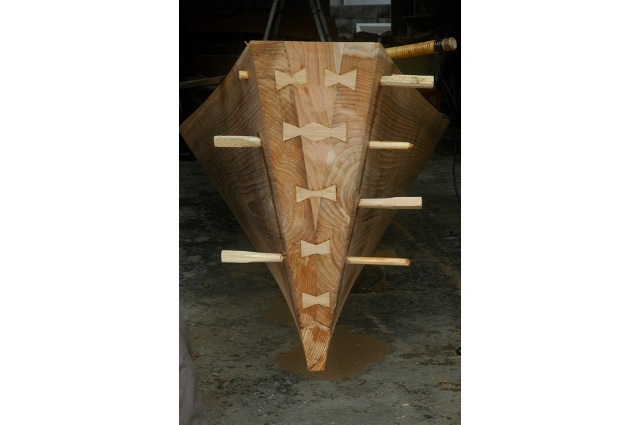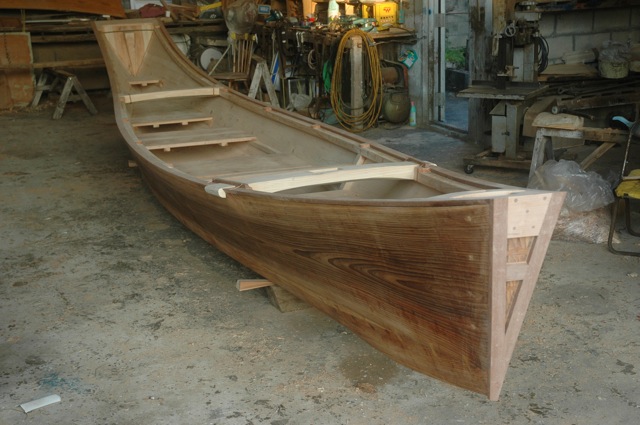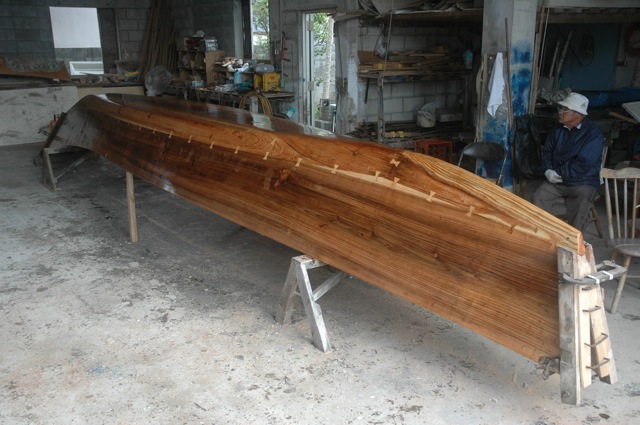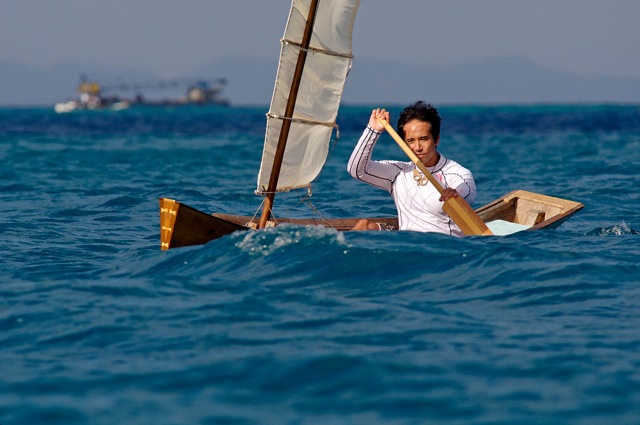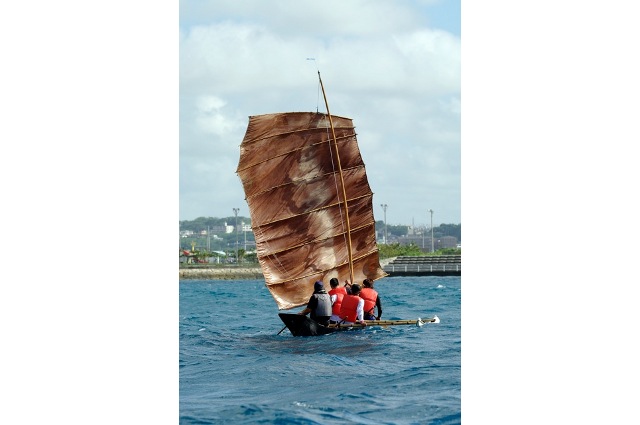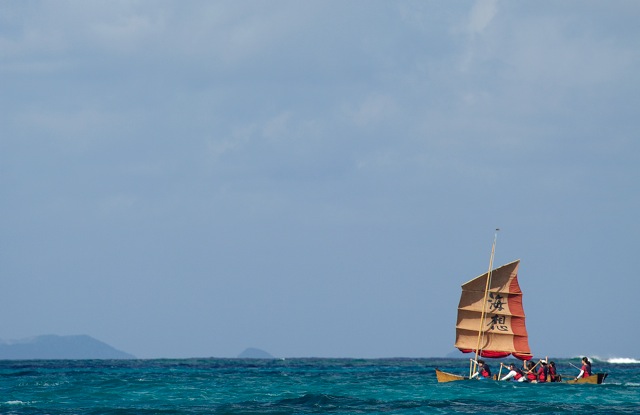Sabani

Mr. Ryujin Shimojo, boat builder, visible in white hat watching while a yuta, or female shaman, performs a ceremony blessing the new sabani.
Photograph by Sgt. Emery Ruffin, USMC.
I spent almost three months the winter of '09/'10 in Okinawa, on the little island of Iejima, working with an 81-year old boatbuilder, Mr. Ryujin Shimojo. He is one of the last three men, now all elderly, who can build the sabani, the traditional fishing boat of this region. This was my fifth apprenticeship with a Japanese boatbuilder. Shimojo san had built over 100 sabani in his career and, like most of my teachers, he used no drawings. He worked entirely from memory, and my job was to document his techniques and record his secret dimensions.
One of the most distinctive features of the sabani is the use of wooden dovetail keys for fastenings. Called huundu, these are commonly used by furnituremakers in the West, but the idea of fastening a boat with them has long fascinated me. I tried earlier to work with a river boat builder on Japan’s main island to learn this technique, but he became too ill to work, so I turned to Okinawa. The first step was raising money, and in 2008 I received an Edwin Monk Scholarship from the Center For Wooden Boats in Seattle. This was followed in 2009 by a grant from the Asian Cultural Council in New York. Late in 2009 the Nippon Foundation provided funding to the Museum of Maritime Science in Tokyo, and Chief Curator Nobuyuki Kobori helped me finalize arrangements with Mr. Shimojo.



I arrived on Okinawa mid-November, 2009 and we went straight to work. Though Shimojo has been slowed by a stroke, we worked at his normal schedule: seven days a week. Most days his son Tomio also helped us. In many ways the process of building a sabani was a revelation. The boats are semi-dugouts, featuring thick cedar side planking fastened to an enormous timber bottom. The major components of the boat are hollowed, including the planking, which started as 2-1/2 inch thick planks which we hollowed to about half their depth, leaving material for the rails, thwart risers and chines. The bottom timbers were nearly six inches thick in the rough; we would eventually remove almost half their volume shaping them inside and out. All parts of of the boat were fastened with a combination of huundu and bamboo nails. The only steel fastenings in the boat were the nails fastening the rubrails, but Shimojo san explained to me that in the old days these too had been bamboo nails.
Shimojo san had built his early sabani entirely with hand tools. Electric power did not come to Iejima until the mid-1960s, but he told me that in his prime he could build an eight meter sabani, entirely by hand, in forty working days. Now he relies on an electric hand plane and sander, since a stroke three years ago forces him to work one-handed. Despite these difficulties, Shimojo san has built two seven meter and one four meter sabani in the last three years.
Our boat was eight meters long, which represented a typical large fishing sabani of the immediate post-War era. Sabani were actually sized by their beam, and our boat was just over four feet wide, incredibly narrow given its length. It would have been sailed and paddled by up to six men, but Shimojo san enjoyed telling me stories of his time spent fishing in his youth, sailing alone in a four meter sabani, the steering paddle in one hand, the sheet in the other, and the fishing line held in his teeth!
Sabani are notoriously difficult to sail, and the region’s fishermen were adept at righting them, and sometimes capsizing them as well, to ride out storms under the hull. Shimojo san claimed that the sabani’s distinctive shape, with its high stern, was ideal for large ocean swells.
World War II changed everything on Okinawa, as the quiet pre-War years (when many fishermen were still sailing dugouts) were shattered by war and occupation. By the 1950’s builders like Shimojo san were installing small gasoline engines in sabani, and the boats were getting larger. By the 1970’s fishermen were switching to boats modeled on the hard chine designs common elsewhere in Japan, first in wood and then fiberglass. Shimojo san adapted with the times, opening a machine shop and later building glass boats. However, many times over the course of the project he told me the true test of a boat builder’s skill was the sabani. "Plank boats are easy," he would say, "Just set up some frames and bend planks around them. Fiberglass? Just spread the stuff and you have a boat."
Shimojo san’s chance to build these iconic boats again came ten years ago when a new generation of watersports enthusiasts began racing sabani. Now forty-five teams sail and paddle these boats in races, including an annual inter-island race of more than twenty-five miles. Okinawa’s three remaining builders have enjoyed second careers building racing sabani, though many of the boats in the fleet are restored fishing boats over forty years old.




Except for an extended New Year’s holiday we worked straight through to the boat’s completion in mid-January, a total of forty-eight working days. A few weeks later a yuta, or female shaman, blessed the boat, which is now on display at the Museum of Maritime Science in Tokyo. The Museum will publish my book - in Japanese - on building this sabani, complete with drawings and photographs.
During the building I posted to this blog.
© Copyright Douglas Brooks, 2007 - 2018. All rights reserved

